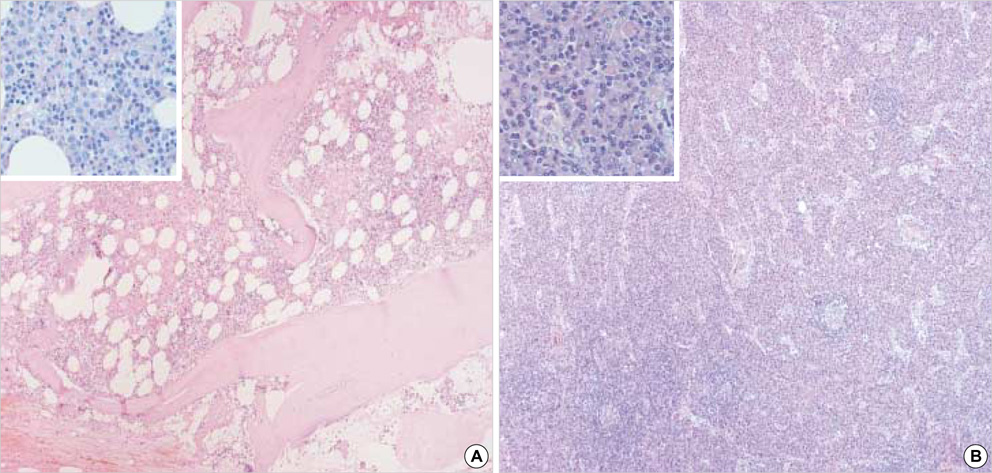J Korean Med Sci.
2005 Jun;20(3):506-508. 10.3346/jkms.2005.20.3.506.
A Case of Reactive Plasmacytosis Mimicking Multiple Myeloma in A Patient with Primary Sjogren's Syndrome
- Affiliations
-
- 1Department of Internal Medicine, Ewha Womans University College of Medicine, Seoul, Korea. leejisoo@ewha.ac.kr
- 2Department of Pathology, Ewha Womans University College of Medicine, Seoul, Korea.
- KMID: 1778516
- DOI: http://doi.org/10.3346/jkms.2005.20.3.506
Abstract
- Primary Sjogren's syndrome (pSS) is a chronic autoimmune disease with welldocumented association of lymphoid malignancies during the progress of the disease. Although several types of malignancy and pseudomalignancy have been reported in pSS, low-grade non-Hodgkin's lymphomas are the most frequently observed. Reactive plasmacytosis mimicking myeloma is a very rare condition in association with pSS. We describe a 72-yr-old woman with pSS who presented with hypergammaglobulinemia, and extensive bone marrow and lymph node plasmacytosis, which mimicked multiple myeloma. In this patient, there was an abnormal differentiation of memory B cells to plasma cells in the peripheral blood suggesting underlying pathogenetic mechanism for this condition.
MeSH Terms
Figure
Reference
-
1. Talal N, Bunim JJ. The development of malignant lymphoma in the course of Sjögren's syndrome. Am J Med. 1964. 36:529–540.
Article2. Pavlidis NA, Drosos AA, Papadimitriou C, Talal N, Moutsopoulos HM. Lymphoma in Sjögren's syndrome. Med Ped Oncol. 1992. 20:279–283.3. Tanvetyanon T, Leighton JC. Severe anemia and marrow plasmacytosis as presentation of Sjögren's syndrome. Am J Hematol. 2002. 69:233.
Article4. Odendahl M, Jacobi A, Hansen A, Feist E, Hiepe F, Burmester GR, Lipsky PE, Radbruch A, Dorner T. Disturbed peripheral B lymphocyte homeostasis in systemic lupus erythematosus. J Immunol. 2000. 165:5970–5979.
Article5. McGovern TW, Erickson AR, Fitzpatrick JE. Sjögren's syndrome plasma cell panniculitis and hidradenitis. J Cutan Pathol. 1996. 23:170–174.6. Vitali C, Tavoni A, Simi U, Viegi G, Bombardieri S. A plasma cell granuloma in a patient with Sjögren's syndrome. J Rheumatol. 1985. 12:1212–1214.7. Bohnhorst J, Thoen JE, Natig JB, Thompson KM. Significantly depressed percentage of CD27+ (memory) B cells among peripheral blood B cells in patients with primary Sjögren's syndrome. Scand J Immunol. 2001. 54:421–427.8. Bohnhorst J, Bjorgan MB, Thoen JE, Jonsson R, Natvig JB, Thompson KM. Abnormal B cell differentiation in primary Sjögren's syndrome results in a depressed percentage of circulating memory B cells and elevated levels of soluble CD27 that correlate with serum IgG concentration. Clin Immunol. 2002. 103:79–88.
Article9. Knowles DM, Athan E, Ubriaco A, McNally L, Inghirami G, Wieczorek R, Finfer M, Jakobiec FA. Extranodal noncutaneous lymphoid hyperplasias represent a continuous spectrum of B-cell neoplasia: demonstration by molecular genetic analysis. Blood. 1989. 73:1635–1645.
Article
- Full Text Links
- Actions
-
Cited
- CITED
-
- Close
- Share
- Similar articles
-
- Primary Sjogren's syndrome manifested as multiple sclerosis and cutaneous erythematous lesions: a case report
- Two Cases of Primary Sjogren's Syndrome Presenting as Relapsing-Remitting Multiple Sclerosis
- Manifestations Like Multiple Sclerosis in a Paitent with Rheumatoid Arthritis and Sjogren's Syndrome
- A Case of Autonomic Dysfunction and Painful Sensory Neuropathy in Sjogren's Syndrome
- One Case of Subacute Sensory Ataxic Neuropathy Associated with Primary Sj gren's Syndrome: A case report



